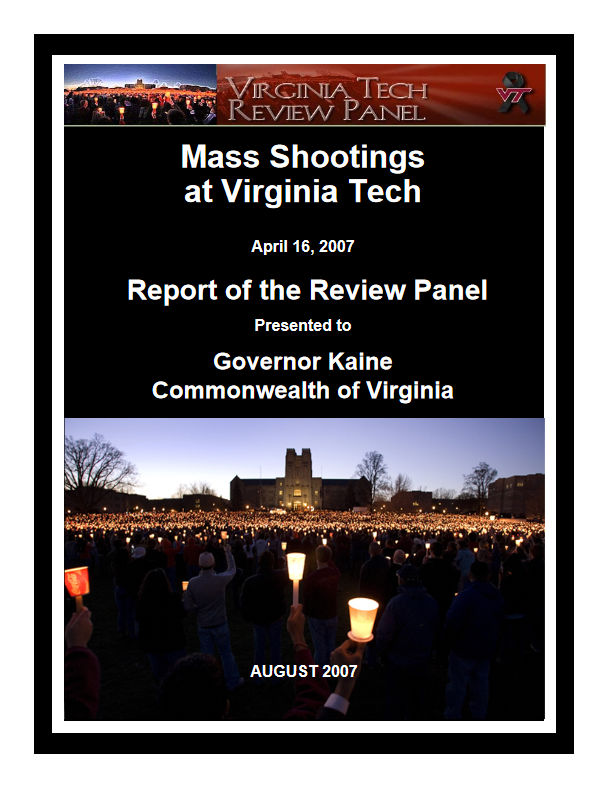 This week marks 12 years since the tragic shooting at Virginia Tech, where 32 people were killed and 23 wounded. I recently re-read the report of the Virginia Tech Review Panel, which was presented to the governor of Virginia back in 2007, with an addendum issued in 2009.
This week marks 12 years since the tragic shooting at Virginia Tech, where 32 people were killed and 23 wounded. I recently re-read the report of the Virginia Tech Review Panel, which was presented to the governor of Virginia back in 2007, with an addendum issued in 2009.
One of key security lessons learned was that the shooter chained the exterior doors of Norris Hall at the beginning of the attack. According to the report: “The chaining had the dual effect of delaying anyone from interrupting his plan and keeping victims from escaping.” Because the doors secured by the shooter delayed law enforcement response as well as deterring egress, it clearly had an effect on the outcome of the incident. This reinforces the need for security that allows free egress from the inside and authorized access from the outside – as required by the model codes.
It’s also clear that classroom doors that were lockable from the inside would have saved lives at Virginia Tech. The report states:
“Virginia Tech did not have classroom door locks operable from the inside of the room. Whether to add such locks is controversial. They can block entry of an intruder and compartmentalize an attack. Locks can be simple manually operated devices or part of more sophisticated systems that use electromechanical locks operated from a central security point in a building or even university-wide. The locks must be easily opened from the inside to allow escape from a fire or other emergency when that is the safer course of action. While adding locks to classrooms may seem an obvious safety feature, some voiced concern that locks could facilitate rapes or assaults in classrooms and increase university liability. (An attacker could drag someone inside a room at night and lock the door, blocking assistance.) On the other hand, a locked room can be a place of refuge when one is pursued. On balance, the panel generally thought having locks on classroom doors was a good idea.”
 Given the concerns of the review panel about the potential for locks to be used improperly, increasing the risk of harm, it’s surprising that Virginia is currently discussing the possibility of allowing classroom barricade devices that don’t meet the requirements of the state’s adopted codes. The original text of Virginia Senate Bill 1755 would have allowed barricade devices to be used, but a revision to the bill instead requires a group of stakeholders to study the issue and develop code change proposals related to school safety and security. This includes the examination of locking devices, barricade devices, and other safety measures that may be utilized in an active shooter or hostile threat situation in a school.
Given the concerns of the review panel about the potential for locks to be used improperly, increasing the risk of harm, it’s surprising that Virginia is currently discussing the possibility of allowing classroom barricade devices that don’t meet the requirements of the state’s adopted codes. The original text of Virginia Senate Bill 1755 would have allowed barricade devices to be used, but a revision to the bill instead requires a group of stakeholders to study the issue and develop code change proposals related to school safety and security. This includes the examination of locking devices, barricade devices, and other safety measures that may be utilized in an active shooter or hostile threat situation in a school.
What would be the justification for adding barricade devices?
You need to login or register to bookmark/favorite this content.






One vulnerability I’ve noticed for a while now is “traditional” panic exit devices, which make it extremely easy for someone to chain-and-padlock double doors–whether this “someone” is an active shooter–or someone who wants “extra security”, doesn’t want students/customers using that exit, or feels forced into it due to a broken lock and a school district facilities department that refuses to repair it.
Another advantage of “pushpad” panic exit devices.
Thank you for making reports readily available. I do read them out of necessity. Like yourself, and anyone else in the industry, I have to defend the use of code compliant locks to my non-industry friends on a regular basis.
Thank you Lori, for the reminders and articles that keeps this a major topic of discussion. “Because the doors secured by the shooter delayed law enforcement response as well as deterring egress, it clearly had an effect on the outcome of the incident.”